| Listing 1 - 9 of 9 |
Sort by
|
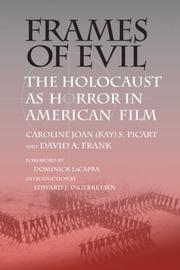
ISBN: 0809327244 9780809327249 Year: 2006 Publisher: Carbondale Southern Illinois University Press
Abstract | Keywords | Export | Availability | Bookmark
 Loading...
Loading...Choose an application
- Reference Manager
- EndNote
- RefWorks (Direct export to RefWorks)
Book
ISBN: 9782874493201 Year: 2016 Volume: *33 Publisher: Bruxelles : Les impressions nouvelles,
Abstract | Keywords | Export | Availability | Bookmark
 Loading...
Loading...Choose an application
- Reference Manager
- EndNote
- RefWorks (Direct export to RefWorks)
Une analyse consacrée au film de S. Spielberg, que l'auteur essaye d'approcher en évitant la polémique existant autour du long-métrage depuis sa sortie en 1993. Il propose ainsi une réévaluation critique du film mettant en avant son caractère complexe, foisonnant, hybride et parfois malhabile. ©Electre 2016 Le Fils de Saul de László Nemes est venu récemment ranimer la question de la représentation cinématographique du génocide juif. C'est ainsi que le film de Steven Spielberg, La Liste de Schindler, s'est de nouveau retrouvé au coeur de tous les débats. Le constat est accablant : plus de vingt ans après sa sortie, celui-ci pâtit toujours de la polémique qu'il a provoquée et se trouve aujourd'hui réduit à quelques lieux communs qui semblent empêcher toute réévaluation critique. Or La Liste de Schindler est une oeuvre complexe, foisonnante, hybride - parfois malhabile, toujours passionnante. Elle est surtout une déclaration de foi en faveur d'une certaine forme de cinéma : un cinéma fictionnel, narratif, figuratif, en un mot classique. Forme largement dominante certes, mais dont Spielberg prouve avec ce film l'incroyable richesse sémantique - pour peu que l'on sache lire et déchiffrer ce qui nous est donné à voir. ± J'aime beaucoup Steven Spielberg et ses films mais, quand il a réalisé La Liste de Schindler, il n'a pas suffisamment réfléchi à ce qu'étaient le cinéma et la Shoah, et comment les combiner
La liste de Schindler (Film) --- Schindler's List (Film) --- Schindler's List (Motion picture) --- Film criticism --- Genocide in motion pictures --- Critique cinématographique --- Génocide au cinéma --- Spielberg, Steven --- Schindler's list (Motion picture) --- Shoah --- Au cinéma --- Schindler's list (film) --- Histoire et critique --- Critique cinématographique --- Génocide au cinéma --- Holocaust [Jewish ] (1939-1945) --- In motion pictures --- Au cinéma.
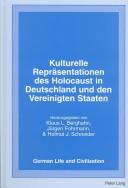
ISBN: 0820452084 Year: 2002 Volume: vol. 38 Publisher: New York : P. Lang,
Abstract | Keywords | Export | Availability | Bookmark
 Loading...
Loading...Choose an application
- Reference Manager
- EndNote
- RefWorks (Direct export to RefWorks)
Holocaust, Jewish (1939-1945), in motion pictures --- Holocaust, Jewish (1939-1945), in literature --- Holocauste, 1939-1945, au cinéma --- Holocauste, 1939-1945, dans la littérature --- Congresses. --- Congrès --- Congrès --- Schindler's list (Motion picture) --- Schindler's list (Film)
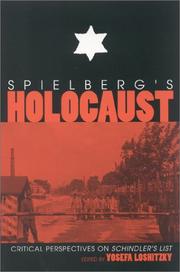
ISBN: 0253210984 025333232X 9780253332325 9780253210982 Year: 1997 Publisher: Bloomington, Ind. Indiana University Press
Abstract | Keywords | Export | Availability | Bookmark
 Loading...
Loading...Choose an application
- Reference Manager
- EndNote
- RefWorks (Direct export to RefWorks)
Spielberg, Steven --- Holocaust, Jewish (1939-1945), in motion pictures. --- #SBIB:309H1323 --- #SBIB:309H1327 --- Motion pictures --- Films met een amusementsfunctie en/of esthetische functie: auteurs --- Films met een amusementsfunctie en/of esthetische functie: script --- Holocaust, Jewish --- Schindler's list (Motion picture) --- Schindlers Liste (Motion picture) --- Holocaust, Jewish (1939-1945), in motion pictures
Book
Year: 2001 Publisher: London Athlone Press
Abstract | Keywords | Export | Availability | Bookmark
 Loading...
Loading...Choose an application
- Reference Manager
- EndNote
- RefWorks (Direct export to RefWorks)
Schindler's List (Motion picture) --- Walker (Motion picture) --- Yield to the Night (Motion picture) --- Shoah (Motion picture) --- Mississippi Burning (Motion picture) --- Black God, White Devil (Motion picture) --- The Civil War (Television series) --- Crime Story (Television series) --- Dance with a Stranger (Motion picture) --- Burns, Ken --- Morris, Errol
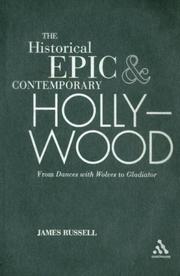
ISBN: 9780826427984 0826427987 9780826427991 0826427995 Year: 2007 Publisher: London ; New York Continuum
Abstract | Keywords | Export | Availability | Bookmark
 Loading...
Loading...Choose an application
- Reference Manager
- EndNote
- RefWorks (Direct export to RefWorks)
Dances with Wolves (Film) --- Dances with Wolves (Motion picture) --- Danse avec les loups (Film) --- Gladiator (Film) --- Gladiator (Motion picture) --- Il faut sauver le soldat Ryan (Film) --- La liste de Schindler (Film) --- La passion du Christ (Film) --- Le prince d'Egypte (Film) --- Saving Private Ryan (Film) --- Saving Private Ryan (Motion picture) --- Schindler's List (Film) --- Schindler's List (Motion picture) --- The Passion of the Christ (Film) --- The Passion of the Christ (Motion picture) --- The Prince of Egypt (Film) --- The Prince of Egypt (Motion picture) --- The passion of the Christ (Film) --- Epic films --- Historical films --- History and criticism. --- United States --- History and criticism
Book
ISBN: 9781405146036 9781405146029 Year: 2008 Volume: 3 Publisher: Malden, Mass. Blackwell
Abstract | Keywords | Export | Availability | Bookmark
 Loading...
Loading...Choose an application
- Reference Manager
- EndNote
- RefWorks (Direct export to RefWorks)
Gladiator (Film) --- Gladiator (Motion picture) --- Il faut sauver le soldat Ryan (Film) --- JFK (Film) --- JFK (Motion picture) --- La liste de Schindler (Film) --- Saving Private Ryan (Film) --- Saving Private Ryan (Motion picture) --- Schindler's List (Film) --- Schindler's List (Motion picture) --- Spartacus (Film) --- Spartacus (Motion picture) --- United 93 (Film) --- United 93 (Motion picture) --- World Trade Center (Film) --- World Trade Center (Motion picture) --- #SBIB:309H1326 --- Films met een amusementsfunctie en/of esthetische functie: genres en richtingen --- Historical films --- History and criticism. --- Film --- United States --- History and criticism --- United States of America
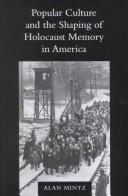
ISBN: 029580369X 9780295803692 0295981202 9780295981208 029598161X 9780295981611 Year: 2001 Publisher: Seattle
Abstract | Keywords | Export | Availability | Bookmark
 Loading...
Loading...Choose an application
- Reference Manager
- EndNote
- RefWorks (Direct export to RefWorks)
The Holocaust took place far from the United States and involved few Americans, yet rather than receding, this event has assumed a greater significance in the American consciousness with the passage of time. As a window into the process whereby the Holocaust has been appropriated in American culture, Hollywood movies are particularly luminous. Popular Culture and the Shaping of Holocaust Memory in America examines reactions to three films: Judgement at Nuremberg (1961), The Pawnbroker (1965), and Schindler's List (1992), and considers what those reactions reveal about the place of the Holocaust in the American mind, and how those films have shaped the popular perception of the Holocaust. It also considers the difference in the reception of the two earlier films when they first appeared in the 1960s and retrospective evaluations of them from closer to our own times. Alan Mintz also addresses the question of how Americans will shape the memory of the Holocaust in the future, concluding with observations on the possibilities and limitations of what is emerging as the major resource for the shaping of Holocaust memory -- videotaped survivor testimony. Popular Culture and the Shaping of Holocaust Memory in America examines some of the influences behind the broad and deep changes in American consciousness and the social forces that permitted the Holocaust to move from the margins to the center of American discourse.
Holocaust, Jewish (1939-1945) --- Holocaust, Jewish (1939-1945), in motion pictures. --- Jews --- Public opinion --- Culture in motion pictures. --- Motion pictures --- Catastrophe, Jewish (1939-1945) --- Destruction of the Jews (1939-1945) --- Extermination, Jewish (1939-1945) --- Holocaust, Nazi --- Ḥurban (1939-1945) --- Ḥurbn (1939-1945) --- Jewish Catastrophe (1939-1945) --- Jewish Holocaust (1939-1945) --- Nazi Holocaust --- Nazi persecution of Jews --- Shoʾah (1939-1945) --- Genocide --- World War, 1939-1945 --- Kindertransports (Rescue operations) --- Foreign public opinion, American. --- Influence. --- Historiography. --- Attitudes. --- Nazi persecution --- Persecutions --- Atrocities --- Jewish resistance --- Judgment at Nuremberg (Motion picture) --- Pawnbroker (Motion picture) --- Schindler's list (Motion picture) --- Schindlers Liste (Motion picture) --- Holocaust, Nazi (Jewish Holocaust) --- Nazi Holocaust (Jewish Holocaust) --- Nazi persecution (1939-1945)
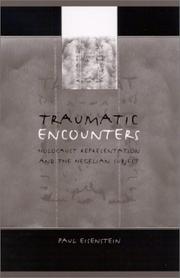
ISBN: 0791486389 1417536136 9781417536139 0791457990 9780791457993 0791458008 9780791458006 9780791486382 Year: 2003 Publisher: Albany : State University of New York Press,
Abstract | Keywords | Export | Availability | Bookmark
 Loading...
Loading...Choose an application
- Reference Manager
- EndNote
- RefWorks (Direct export to RefWorks)
Traumatic Encounters argues for an alternative memorial path in Holocaust and cultural studies—one that shows the vital necessity of thinking in a universal way about an event like the Holocaust. Relying on Hegel's notion that the particular is already universal, Eisenstein shows how the encounter with trauma transpires not in the refusal of a universalizing gesture but rather in its wholesale embrace. This embrace results in a recognition involving the trauma that conditions the possibility of history in the first place—a structural trauma immune to historicization that Hegel and psychoanalysis place at the heart of subjectivity and community. This encounter with structural trauma is at the center of four titles that Eisenstein examines: Spielberg's Schindler's List, D. M. Thomas's The White Hotel, Thomas Mann's Doctor Faustus, and David Grossman's See Under: Love
Judaism and literature. --- Holocaust, Jewish (1939-1945) --- Holocaust, Jewish (1939-1945), in motion pictures. --- Holocaust, Jewish (1939-1945), in literature. --- Motion pictures --- Catastrophe, Jewish (1939-1945) --- Destruction of the Jews (1939-1945) --- Extermination, Jewish (1939-1945) --- Holocaust, Nazi --- Ḥurban (1939-1945) --- Ḥurbn (1939-1945) --- Jewish Catastrophe (1939-1945) --- Jewish Holocaust (1939-1945) --- Jews --- Nazi Holocaust --- Nazi persecution of Jews --- Shoʾah (1939-1945) --- Genocide --- World War, 1939-1945 --- Kindertransports (Rescue operations) --- Literature and Judaism --- Literature --- Influence. --- Historiography --- Philosophy. --- Nazi persecution --- Persecutions --- Atrocities --- Jewish resistance --- Hegel, Georg Wilhelm Friedrich, --- Hegel, Giorgio Guglielmo Frederico --- Hegel, Georg Wilhelm Friedrich --- Schindler's list (Motion picture) --- Schindlers Liste (Motion picture) --- Holocaust, Nazi (Jewish Holocaust) --- Nazi Holocaust (Jewish Holocaust) --- Nazi persecution (1939-1945) --- Hēgeru, --- Hei-ko-erh, --- Gegelʹ, Georg, --- Hījil, --- Khegel, --- Hegel, G. W. F. --- Hegel, --- Hei Ge Er, --- Chenkel, --- Hīghil, --- הגל, --- הגל, גאורג וילהלם פרידריך, --- הגל, גיאורג וילהלם פרידריך, --- הגל, ג.ו.פ, --- היגל, גורג ווילהלם פרדריך, --- היגל, גיורג וילהלם פרידריך, --- 黑格尔, --- Hegel, Guillermo Federico, --- Hegel, Jorge Guillermo Federico, --- Heyel, Georg Wilhelm Friedrich, --- Higil, Gʼūrg Vīlhim Frīdrīsh, --- هگل, --- هگل، گئورگ ويلهم فريدريش,
| Listing 1 - 9 of 9 |
Sort by
|

 Search
Search Feedback
Feedback About UniCat
About UniCat  Help
Help News
News